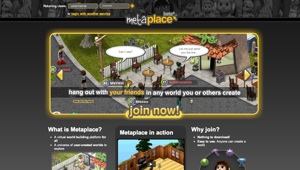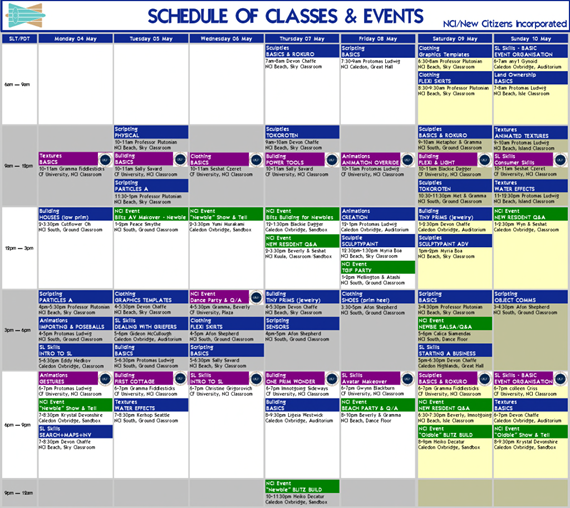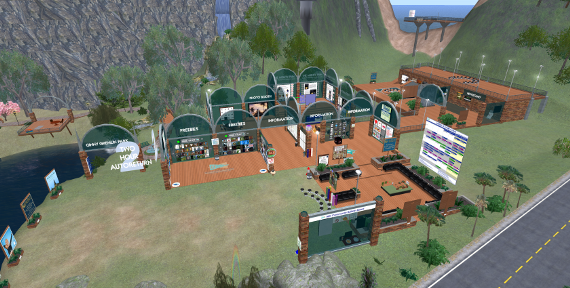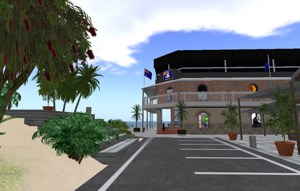1. The Industry Standard (USA) – Real world laws intrude on virtual world behavior. “Navigating the laws of cyberspace is getting ever more complex as virtual worlds themselves become mirrors of the real world. That’s one clear message from a Stanford University event on legal frontiers for digital media that I attended today. Protecting children from predators is at the top of the list. But there are thorny issues about who owns the property created in the worlds, what rights to privacy should users expect, how operators should work with real-world law enforcement, whether gambling with virtual money should be regulated, and in general whether or not real world laws should govern behavior in virtual worlds.”
2. The Boston Globe (USA) – The learning game. “Call me a dinosaur if you like (you won’t be the first), but I believe the best way for kids to learn is simply to read a book and the best place for them to spend their childhood is outdoors. Brace yourselves for one more heresy: I also think that, for all of the Internet’s wonders, it does a lot more to distract young children than to inform them.”
3. Fast Company (USA) – OpenShaspa: Energy Management in a Virtual World. “Want to manage your energy consumption by playing a video game? The OpenShaspa Home Energy Kit aims to do just that, by letting you oversee energy management in a virtual world. Shaspa’s kit, which is constructed from open-source components, contains a system of wireless sensors that control home energy output. The sensors can send data to cell phones and Internet applications like Google’s upcoming PowerMeter. Additional sensors for utility resources like gas and water can also be tacked on. Wireless sensor networks are becoming increasingly common, but OpenShaspa’s virtual world adds a new element to smart grid energy monitoring. OpenShaspa can be linked to an open-source spin-off of Second Life called OpenSimulator.”
4. Wired (USA) – Simulate Star Clusters with Second Life Mod. “Ever wanted to control the stars with your outstretched arm? An open-source virtual reality platform just made it possible. What in 1991 was a novel physics solution now comes packaged in a virtual world for you to intuitively explore. A new simulation in OpenSim, an open-source version of the popular virtual world Second Life, shows how a handful of objects floating in space react to each others’ gravity. In physics, this is known as the N-body problem. It’s simple if you have only two objects: they orbit their common center of mass in a circle or an ellipse. But three or more objects send the system into chaos. Physicists and mathematicians banged their head against it for centuries, with a general solution emerging less than 20 years ago.”
5. Huffington Post (USA) – Living in Sim. “Is somebody with a joy stick guiding my hands as I type this? Are they making me want to go across the street to Starbucks right now? Are we all living in a computer simulation? With Sims 3 coming out next month, it seems worth pondering. Sims, to help the uninitiated, is a sophisticated and addictive life simulation game. Millions of people are immersed in it, as well as in Second Life and World of Warcraft. Me and my kids were once avid players of Sims. Then one day a Sims character got into her hot tub, became drained of life force and never got out. ”
6. Singapore Entrepreneurs (Singapore) – Interview With Simon Newstead, Founder Of Frenzoo. “Based in Hong Kong, Frenzoo brings fashion online and in the form of 3D avatars. They will be here in Singapore to present at unConference 2009 and we had a chat with Simon Newstead, founder of Frenzoo.”
7. Government of Jamaica Information Service (Jamaica) – Protecting Children in Cyberspace. “The Internet, cyberspace, represents one of the greatest technological advancements of the 20th century and plays an important role in all aspects of life but most importantly communication, education, commerce and entertainment. It has radically changed global social interactions. Many of you have witnessed children sitting beside each other but communicating via texting, instant messaging or by e-mail. The larger the group, the more the children seem to have fun. Their fascination with the social networking websites such as Hi5, Facebook and MySpace is unabated.”
8. How Do (UK) – Salford students clean up kitchens… in Second Life. “Here on How-Do we’ve seen pop stars, award ceremonies and even academic qualifications delivered through the virtual reality of Second Life… but students cleaning up dirty kitchens? Surely some mistake. Apparently not. In what is being hailed as a first of its kind kind of thing in the UK, Salford University environmental health students have been thrown into dirty and dangerous kitchens in the virtual world and told to clean them up.”
9. AsiaOne (SIngapore) – Philippines’ tourism campaign engages audience of new media. “Forget mere traditional advertisements and colourful brochures; the Philippines is getting edgier with new media to posture itself as a destination for the adventurous and music lovers. The “Awesome Philippines” tourism campaign, in partnership with MTV Networks, has harnessed interactive websites and virtual realities in reaching out to its target market of 18- to 35-year-olds, the age group deemed to be the most adventurous and thrill-seeking. The campaign’s most recent outreach tool is the creation of a simulated microcosm of the Philippines that Department of Tourism (DoT) Secretary, Mr “Ace” Joseph Durano has monikered the country’s “7,108th” island in the online virtual reality Second Life (SL).”
10. Web Worker Daily (USA) – Second Life Is Social Media. “Despite all of the hype about Second Life, followed by the Second Life bashing, followed by some more hype, and now the latest “Second Life is dead†pronouncements, the 3-D virtual world owned by Linden Lab is still breathing. I feel strongly — as do many others — that Second Life is an important, and often overlooked, aspect of social media marketing. To be clear, Second Life is social media. If you break down the key features of social media, you will see that Second Life stacks up very well against other popular tools. Here are some of the reasons why you’d be remiss to leave Second Life off a well-rounded, integrated social media marketing plan.”
 1. Second Life educator extraordinaire, Jokay Wollongong, is having a Eurovision party this coming Sunday.
1. Second Life educator extraordinaire, Jokay Wollongong, is having a Eurovision party this coming Sunday.


 1. Need to create terrain on an OpenSim grid?
1. Need to create terrain on an OpenSim grid?
Recent Comments